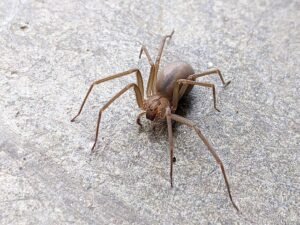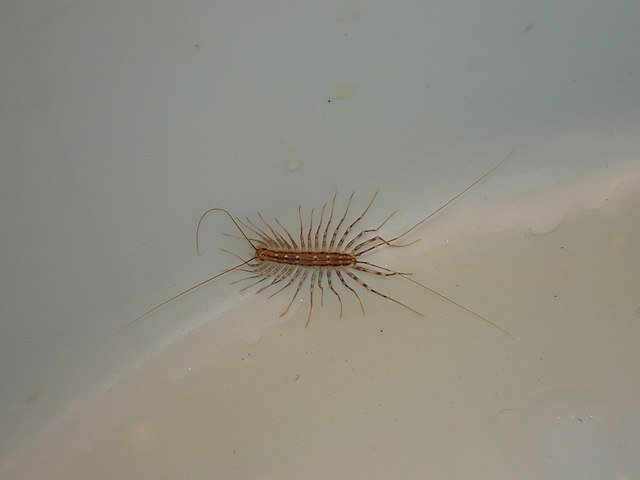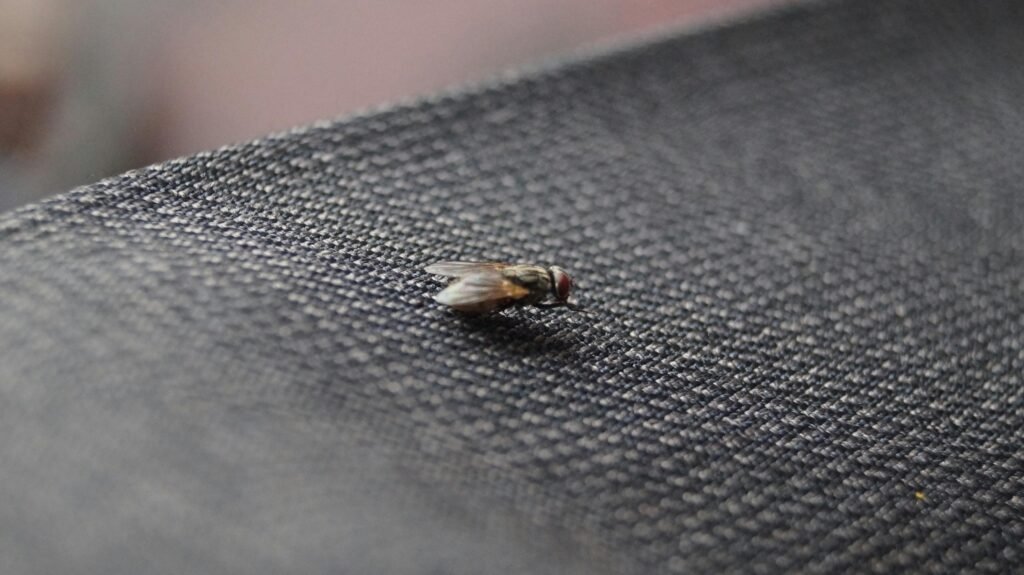Brown Recluse Spider: Identification, Risks, and Control Guide
 The brown recluse spider (Loxosceles reclusa) is one of the most feared spiders in North America. Unlike harmless household spiders such as the cellar spider (Pholcus phalangioides), this species has venom capable of causing medically significant reactions. Its reputation comes from the necrotic lesions that sometimes develop after a bite, although severe outcomes remain relatively rare.
The brown recluse spider (Loxosceles reclusa) is one of the most feared spiders in North America. Unlike harmless household spiders such as the cellar spider (Pholcus phalangioides), this species has venom capable of causing medically significant reactions. Its reputation comes from the necrotic lesions that sometimes develop after a bite, although severe outcomes remain relatively rare.
Despite their notoriety, brown recluse spiders are naturally shy. They prefer hidden, undisturbed places such as basements, attics, closets, and sheds. Most encounters occur when people accidentally disturb them while cleaning, handling stored items, or putting on clothes or shoes.
This article provides a complete overview of L. reclusa, covering identification, biology, global distribution, risks, prevention, and control strategies.
Identification
Correct identification is critical, since many harmless spiders are mistaken for brown recluses.
Size: Adults range from 6 to 20 mm (¼–¾ inch) in body length.
Color: Light to medium brown, sometimes with a grayish or yellow tint.
Marking: A dark, violin-shaped marking on the cephalothorax, with the "neck" of the violin pointing toward the abdomen. This is their most distinctive feature.
Eyes: Unlike most spiders, which have eight eyes, L. reclusa has six eyes arranged in pairs (dyads) in a semicircle.
Legs: Uniformly colored without spines, giving them a smooth appearance.
Webs: They do not build traditional orb webs. Instead, they spin irregular, sticky silk retreats in hidden places.
When compared with black widow spiders (Latrodectus spp.), which have shiny black bodies and a red hourglass marking, the brown recluse is much less conspicuous.
Biology and Ecology
The survival success of the brown recluse is tied to its adaptability to human environments.
Diet: Carnivorous, feeding on small insects such as crickets, cockroaches, and ants. They hunt at night and rely on ambush rather than web traps.
Habitat: Prefer dark, dry, and undisturbed areas. Indoors, they hide in storage boxes, shoes, folded clothing, and clutter. Outdoors, they live under rocks, woodpiles, and sheds.
Reproduction: Females lay egg sacs containing about 40–50 eggs. Multiple sacs may be produced in a season, leading to rapid population growth if left unchecked.
Behavior: Solitary and reclusive, they avoid confrontation but will bite when pressed against skin.
Like the hobo spider (Eratigena agrestis), brown recluses are part of the family Sicariidae, which includes other species with necrotic venom.
Global Distribution
The brown recluse has a limited but expanding range.
United States: Native to the Midwest and South, with strong populations in states like Missouri, Arkansas, Oklahoma, Texas, and Kansas.
Spread: Due to human travel and commerce, they occasionally appear in non-native states, but established populations outside their core range are rare.
Other countries: Related species in the genus Loxosceles exist in Central and South America, the Mediterranean, and Africa. These relatives share similar venom properties and appearance.
Unlike cosmopolitan spiders such as the house spider (Parasteatoda tepidariorum), L. reclusa remains largely regional.
Risks and Damage
The primary concern with brown recluse spiders is their venom.
Bite effects:
Initial bite may be painless or mildly irritating.
Within hours, redness, swelling, and itching can develop.
In severe cases, necrotic skin lesions form, sometimes requiring medical intervention.
Systemic reactions are rare but may include fever, chills, or malaise.
Medical significance:
Most bites heal without complications.
Severe necrosis occurs in a minority of cases, often exaggerated by myths and misdiagnosis.
Economic and psychological impact:
Infestations cause anxiety in households.
Businesses may suffer reputation loss if spiders are reported in hotels, hospitals, or schools.
While mosquitoes (Culex spp.) are vectors of widespread diseases, the brown recluse is feared because of localized but dramatic bite outcomes.
Signs of Infestation
Detecting a brown recluse infestation requires careful inspection:
Sightings: Spiders in corners, storage boxes, or clothing.
Webs: Small, irregular silk retreats rather than large orb webs.
Egg sacs: Off-white, loosely woven spheres hidden in dark spaces.
Dead insects: Remains of prey may accumulate near retreats.
Because they are nocturnal and reclusive, infestations often go unnoticed until populations grow.
Control Methods
Managing brown recluse spiders requires patience and thoroughness.
Sanitation:
Reduce clutter, especially cardboard boxes and clothing piles.
Regularly clean basements, attics, and storage areas.
Exclusion:
Seal cracks in walls, windows, and doors.
Install weatherstripping and repair torn screens.
Mechanical control:
Use sticky traps to monitor and capture spiders.
Vacuum visible spiders and egg sacs.
Chemical treatments:
Residual insecticides can be applied to baseboards, corners, and entry points.
Dust formulations like silica aerogel or diatomaceous earth help in hidden voids.
Professional services:
For heavy infestations, licensed pest control experts can provide targeted treatments.
Compared to cockroach infestations, where baits are highly effective, spider management focuses more on habitat reduction and exclusion.
Advanced Approaches
More advanced strategies are sometimes needed:
Integrated Pest Management (IPM): Combining sanitation, exclusion, monitoring, and limited pesticide use.
Biological research: Studies into natural predators such as centipedes (Chilopoda) and wasps are ongoing, though not practical for homes.
Education: Teaching residents to reduce fear-driven overreactions and correctly identify the species prevents unnecessary panic.
Cultural and Historical Context
The brown recluse has gained an outsized reputation in American culture:
Folklore: Often portrayed as a dangerous, lurking threat, similar to the image of black widows.
Media coverage: Bite cases are widely reported, sometimes exaggerated, reinforcing public fear.
Symbolism: The “recluse” name reflects its hidden lifestyle, adding to its mystique.
Scientific interest: Venom components are studied for potential medical applications, including tissue-targeting enzymes.
Like the tarantula (Theraphosidae), the brown recluse has become an icon of fear, despite actual risks being more limited than perception suggests.
FAQ
Q1: Are brown recluse spiders aggressive?
No. They are shy and prefer to retreat. Most bites occur when the spider is accidentally trapped against the skin.
Q2: What should I do if bitten?
Wash the bite with soap and water, apply a cold compress, and seek medical advice. Not all bites cause necrosis, but professional evaluation is recommended.
Q3: How dangerous is a brown recluse compared to a black widow?
Black widow venom affects the nervous system, while brown recluse venom can cause localized tissue damage. Both are medically significant but rarely fatal.
Q4: Can brown recluse spiders infest entire houses?
Yes. They can live in walls, attics, and basements, reproducing quickly if left uncontrolled.
Q5: Do pest control sprays alone eliminate infestations?
Not usually. Sprays help, but habitat reduction, exclusion, and consistent monitoring are essential.
Q6: How can I prevent brown recluse infestations?
Declutter, store clothing and shoes in sealed containers, and use sticky traps for early detection.
Final Thoughts
The brown recluse spider (Loxosceles reclusa) is both misunderstood and over-feared. While its venom can cause necrotic skin lesions and occasionally serious medical reactions, most encounters are harmless and most bites heal without long-term damage. The key challenge is that these spiders thrive in the same hidden spaces humans often neglect—basements, attics, and cluttered storage areas.
From a pest management perspective, control requires more than a single chemical treatment. Long-term success comes from integrated pest management (IPM): reducing clutter, sealing entry points, using sticky traps, and supplementing with targeted pesticides if needed. Education is equally important. By separating fact from myth, people can respond calmly and effectively instead of relying on fear or misinformation.
The brown recluse will likely continue to inspire caution and cultural fascination. But with proper identification, awareness of infestation signs, and proactive prevention, homeowners can manage risks without unnecessary alarm.
Disclaimer
This article is for informational purposes only. Pest control laws and approved chemicals vary by country. For best results and legal safety, we strongly recommend contacting a licensed pest control professional in your local area. Always make sure that the pest control technician is properly certified or licensed, depending on your country’s regulations. It’s important to confirm that they only use approved products and apply them exactly as instructed on the product label. In most places in Europe, UK, or USA, following label directions is not just best practice—it’s the law.
Author Bio
Nasos Iliopoulos
BSc Agronomist & Certified Pest Control Expert
Scientific Director – Advance Services (Athens, Greece)
Licensed Pest Control Business – Ministry of Rural Development & Food (GR)
References
Oklahoma University - Brown Recluse or Fiddleback Spider
Wikipedia - Brown recluse spider


